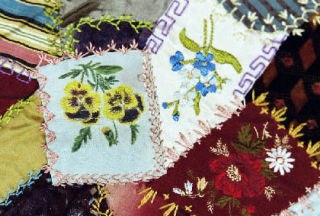Local museum displays unique quilts, patches and embroidery
The White River Valley Museum celebrates the Victorian tradition of crazy quilting with a series of events, including the exhibit “Crazy Quilts: Puzzle Patches and Fanciful Embroidery” that opened May 7 and runs until Aug. 13.
“Crazy Quilts” features a collection of 30 quilts, garments and other items made with the crazy quilting method, most dating from 1880 to 1920. Guest curator, quilter and storyteller Anita Sheneberger organized the exhibit after spending more than four months traveling the back roads of Western Washington to acquire this rare collection of quilts.
“I have two passions in my life besides my family and faith, and they are fabric and story. Quilts fit so naturally into these two obsessions,” Sheneberger said.
Quilting is a centuries-old practice of sewing old and leftover pieces of wool and other fabric together to create useful things like blankets, shirts and dresses. Women during the Colonial era turned to this method to stretch their resources. Over time, quilting evolved from a necessity into a social art form.
Traditional quilting typically uses like-sized patches of fabric to create a uniform pattern. In 1880, crazy quilting started to gain popularity. This new technique created beautiful and seemingly random “crazy” patterns using various sizes and shapes of materials, with nearly every seam and patch adorned with embroidery.
As quilts transitioned from functional to decorative pieces, materials like silk and velvet were incorporated. Crazy quilts celebrated and documented life occasions with stitched birth announcements, wedding dates and even death dates. The crazy quilt phenomenon remained popular until about 1920. Today, many intact quilts and garments from the crazy quilt era are considered historical artifacts worth thousands of dollars.


